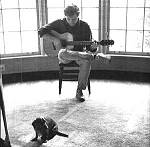Profile: Leo Kottke
by Kevin Ransom

|
In the '70s, when Leo Kottke was blowing our heads off with his staggering 12-string acoustic excursions, some of us half-jokingly fretted: "If he keeps playing that fast, he's going to hurt himself."
Turns out we were right. In the early '80s Kottke developed a severe case of tendinitis that would cause his right arm to freeze just ten minutes into a live set. He was forced to completely revamp his playing style, first discarding his fingerpicks, then his thumbpick, which initially meant a profound loss of speed and volume.
"At first, I sounded like a mouse," laughs Kottke. "I had to learn to play with a lot less force. And without all my right-hand habits, I was left with just the skeleton of my songs. I discovered that without the velocity and that propulsive groove, there wasn't a lot going on in those tunes. It was glaring to me just how little I was doing with my left hand."
For two years Leo was unable to play a lot of his "breadwinners" -- the hyperventilating "Busted Bicycle," the careening "Vaseline Machine Gun," and the stuttering "Jack Fig." "I had to find other ways to keep myself interested, so I spent a lot of time thinking about chords and scales. I got more curious about the different ways to get from chord A to chord B."
That led to Kottke's interest in jazz harmony, "a very strict system that allows you to organize the fretboard to more improvisational ends." Those inclinations were most evident in 1990's That's What, which feature more melodies built on major 7ths and minor chords than on any of his previous records. He displayed similar propensities on parts of 1991's Great Big Boy, the quirky Steve Berlin produced effort that was the first Kottke album to showcase his sonorous baritone voice on every track. Ironically, on Kottke's new Private music release, Peculiaroso, the improvisational aspects of his jazz-guitar studies have led him back to more familiar turf. Many of the tunes are built around the more pentatonic approach of his '70s material.
"When I started out I hated improvisation, because I took classical trombone lessons for nine years as a kid, and the pedagogues pretty much avoid that whole issue," says Kottke dryly. "But now I love it, and since there was a lot more improvisation on this record, I naturally fell into more familiar areas" -- although these tunes are more harmonically complex than his early works.
Peculiaroso was produced by Rickie Lee Jones -- a collaboration that grew out of Kottke's 6- and 12-string work on Jones' Traffic From Paradise. Initially, Peculiaroso was intended as a trio project, with Kottke's signature guitar sound backed by stand-up bass and rums. But Kottke and Jones abandoned that concept halfway through the project adding such embellishments as accordion, string quintet, and electric guitar textures and countermelodies. Several tracks are simply solo Leo. "The more we got into it, Rickie preferred to hear me with less and less," Leo recalls. "She really liked these pieces as solos, and she was torn about doing much to them."
The track most likely to satisfy longtime Kottke disciples is the mournfully resonant "Poor Boy," the John Fahey/Bukka White composition that, more than 25 years ago, was the first slide-guitar tune Kottke ever played. "It's a good example of what I'm trying to do more and more these days: avoid a repetitive dead-thumb rhythm," Kottke explains. Aother Peculiaroso element that recalls Kottke's '70s Capitol releases -- all of which are being reissued by the English B.O.G. [sic] label -- is the accented, syncopated groove laid down by drummer Bill Berg, who played on those seminal '70's discs.
For the Peculiaroso tracks, Leo chose a cedar-top 6-string by Jim Olsen of Minneapolis, a Taylor Leo Kottke model 12-stirng, a Taylor 510 6-string, and an archtop built by Mark Lacey of Hollywood. Except for one tune on which Kottke employed a Sunrise pickup and a Pendulum preamp, everything was recorded acoustically. "We used a mike that's the original AKG verison of the 461," he details. "It had the same capsule and body, but with tube innards."
Besides the seven Kottke-penned songs, Peculiaroso features five covers, including diaphanous, delicately melodic performances of "Twilight Time," "Wonderland By Night," and "Arms of Mary." Kottke notes that these songs are from "this window of wonderful American music by folks like the Platters, the Nat King Cole Trio, and Santo & Johnny. That msuic has a lot to do with the way I hear melodies. For some reason these tunes have been relegated to the schlock barrel, but they fall beautifully onto the guitar. It reminds me of the critic who knocked Verdi's music by saying, 'It all just sounds like a great big guitar.' He meant it as an insult, but I can't imagine a better compliment."